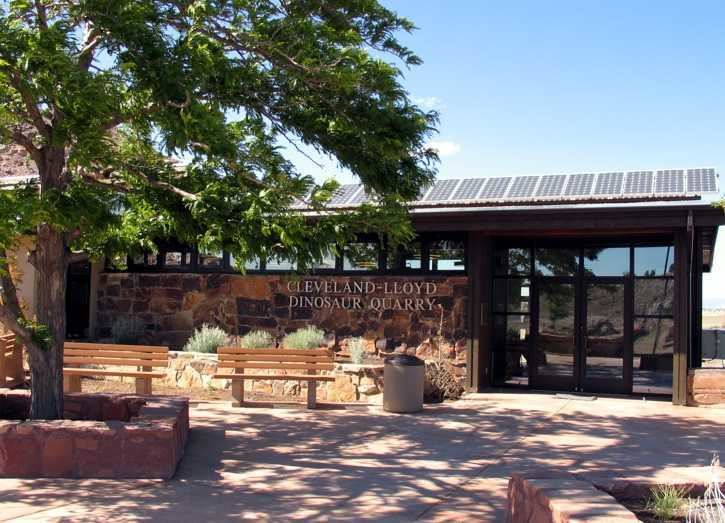Location Emery County, Utah Designated 1965 Phone +1 435-636-3600 | Nearest city Cleveland Address Elmo, UT 84521, USA Management Bureau of Land Management | |
 | ||
Governing body Bureau of Land Management Hours Closed now Monday10AM–5PMTuesday10AM–5PMWednesday10AM–5PMThursday10AM–5PMFriday10AM–5PMSaturday10AM–5PMSunday12–5PM Similar Black Rock Range, Jackson Mountains, Seven Troughs Range, High Rock Canyon Wilderness, Eldorado Mountains | ||
Cleveland lloyd dinosaur quarry san rafael swell utah
The Cleveland-Lloyd Dinosaur Quarry, located in the San Rafael Swell, near Cleveland, Utah, contains the densest concentration of Jurassic dinosaur fossils ever found. Well over 15,000 bones have been excavated from this Jurassic "predator trap" and there are many thousands more awaiting excavation and study. It was designated a National Natural Landmark in October 1965.
Contents
- Cleveland lloyd dinosaur quarry san rafael swell utah
- Cleveland lloyd dinosaur quarry
- VisitingEdit
- HistoryEdit
- GeologyEdit
- PaleofaunaEdit
- References
Cleveland lloyd dinosaur quarry
VisitingEdit
The visitor center is administered by the Bureau of Land Management. There is a skeleton reconstruction of an adult Allosaurus (and other bones) on display in the visitor center, along with many other exhibits. A renovated and expanded quarry visitor center was dedicated on April 28, 2007. The visitor center is open seasonally with variable hours.
HistoryEdit
The quarry was found by sheepmen and cowmen as they drove their animals through the area during the late 19th century. In 1927, the Department of Geology at the University of Utah, under the direction of Chairman F.F. Hintze, visited the area and collected 800 bones. In 1939, a field party from Princeton University led by William Lee Stokes began work. In three summers, they collected 1,200 bones. The quarry was not worked again until 1960. In 1974, a new dinosaur was described by James H. Madsen, Jr., Assistant Research Professor of Geology and Geophysics, University of Utah. He named it Stokesosaurus clevelandi. In 1976, another new dinosaur was described from fossils found in the quarry by Madsen. He named it Marshosaurus bicentesimus. In 1987, Brigham Young University paleontologists excavated a fossil dinosaur egg, at the time the oldest such egg ever found.
Over the years, excavations led by the University of Utah and the Utah Museum of Natural History have resulted in the collection of more than 12,000 fossil bones from the quarry. While most of the original fossils are currently housed at the Utah Museum of Natural History, many skeletons reproduced from Cleveland-Lloyd dinosaur remains are now on exhibit in more than 65 museums worldwide. Original specimens from the quarry remain on public exhibit in Utah at the Utah Museum of Natural History in Salt Lake City, the Utah State University Eastern Prehistoric Museum in Price and the Earth Science Museum at Brigham Young University in Provo.
The U.S. Department of the Interior, Bureau of Land Management (BLM) opened a visitor center at the Cleveland-Lloyd Dinosaur Quarry in 1968. This was the first-ever BLM visitor center. On April 28, 2007 a new, larger facility was dedicated that has updated exhibits. The new visitor center generates its own electricity from rooftop solar panels.
GeologyEdit
The Cleveland-Lloyd Dinosaur Quarry of east central Utah has produced one of the most prolific dinosaurs bone assemblages in the Upper Jurassic beds of North America. The quarry is part of the Brushy Basin Member of the Morrison Formation. The fossil deposit, which is interpreted to be a possible predator trap, consists of a calcareous smectitic mudstone which accumulated on the floodplain of an anastomosing river system. An anastomosing river system consists of multiple interconnected channels confined by prominent levees separated by interchannel topographic lows. The depositional environment of the quarry mudstone was an interchannel seasonal accumulation of clay nested in a topographic low between channel levees called a floodpond.
Dinosaurs became entrapped in the cohesive and adhesive mud as they drank and hunted near the floodpond. The preserved fauna consists of almost all dinosaurs with the majority being carnivorous dinosaurs including Allosaurus (material from at least 44 individuals make up almost 67% of all remains), Torvosaurus (1), Ceratosaurus (1), Stokesosaurus (2), Marshosaurus (2), and possibly an Ornitholestes. Herbivorous dinosaurs include Camarasaurus (5), Haplocanthosaurus (1), Barosaurus (1), Amphicoelias (1), Mongolosaurus (1), an unidentified sauropod, Camptosaurus (5), Stegosaurus (4), a possible ankylosaur (1), and an unidentified ornithopod. Non-dinosaurian fauna include a crocodile (Goniopholis), 2 turtles (Glyptops), 4 genera of gastropoda (snails), and 4 genera of charophyte.
The atypical predator/prey ratio (3:1) represented at the quarry may be explained by pack hunting tendencies of Allosaurus. The high percentage of smaller individual allosaurs suggests that juveniles coordinated their efforts to capture and kill prey. They may have followed their prey into the floodpond and subsequently became mired themselves. The close spatial proximity of skull elements (most belonging to Allosaurus) supports this hypothesis. Larger individual theropods almost certainly became mired while attempting to scavenge the carcasses of other entrapped dinosaurs (Richmond and Morris, 1996).
PaleofaunaEdit
Fossil taxa discovered at the Cleveland-Lloyd site include:
